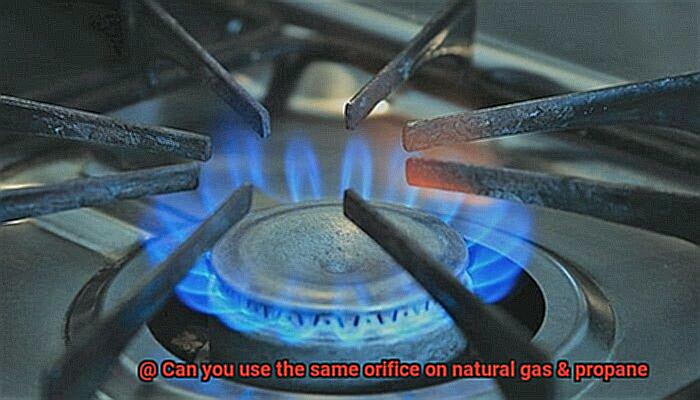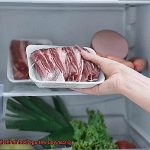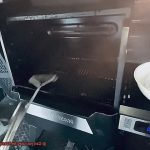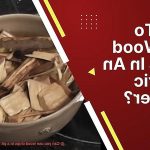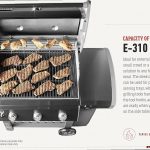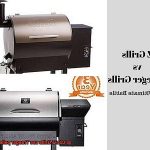Propane and natural gas – two popular fuel sources for gas appliances that power homes and businesses. But did you know that the type of fuel you use can greatly impact the efficiency and performance of your appliances? That’s why when it comes to converting between propane and natural gas, many people wonder if they can use the same orifice on both.
If you’re thinking about switching between propane and natural gas, whether it’s for environmental reasons or because you’re moving into a new home, this is an important question to consider. Unfortunately, there’s no simple answer since it depends on your specific appliance and its gas requirements.
In this blog post, we’ll take a deep dive into the differences between propane and natural gas, exploring how they affect orifice usage. We’ll also discuss the safety considerations involved in making any alterations to your gas appliances. It’s crucial to consult professionals before attempting any conversions to ensure everything is done safely and efficiently.
By the end of this post, you’ll have a better understanding of your appliance’s unique gas needs, how to make adjustments safely, as well as the benefits and drawbacks of each fuel type. So sit back, relax, and get ready to explore the fascinating world of gas appliances and orifices.
Contents
Differences between Natural Gas and Propane
Natural gas and propane are two of the most commonly used fuels for grilling, heating, and cooking. While they may seem interchangeable at first glance, there are significant differences between them that affect how they are used. Let’s take a closer look at the differences between natural gas and propane.
Composition is the first major difference. Natural gas is primarily composed of methane, while propane is a byproduct of natural gas processing and petroleum refining. Propane is denser than natural gas and requires less volume to produce the same amount of heat. This means that propane has a higher energy content than natural gas, making it ideal for outdoor grilling where high temperatures are needed.
Pressure is another significant difference. Natural gas is delivered to homes and businesses through pipelines under low pressure, while propane is typically stored in tanks under high pressure. This difference in pressure affects how the fuel is delivered to appliances and the size of the orifice needed to regulate the flow.
The energy content of propane also makes it an excellent fuel source for heating homes in rural areas where natural gas pipelines are not available. Propane tanks can be easily installed on properties, providing a convenient and reliable source of fuel.
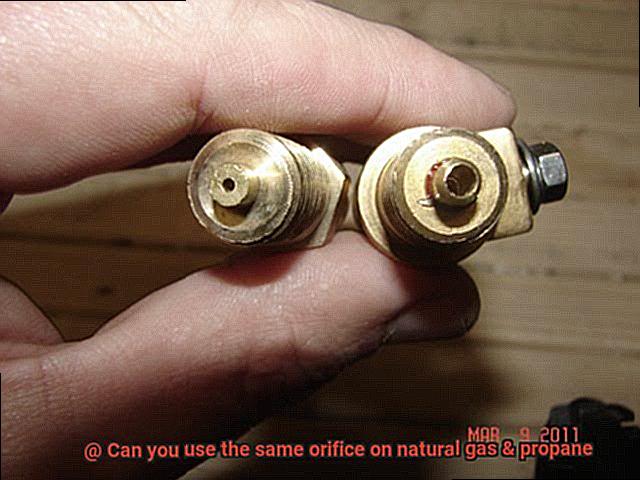
Availability is yet another difference. Natural gas is more widely available in urban areas where it is commonly used for heating homes and businesses. Propane, on the other hand, is often used in rural areas where natural gas pipelines are not available.
When it comes to grilling, it’s essential to use the correct orifice for each fuel type to ensure safe and efficient operation of appliances. Using the wrong orifice can lead to inefficient burning and potentially dangerous situations.
Can You Use the Same Orifice for Both Natural Gas and Propane?
The answer is a resounding no. Let’s take a closer look at why this is the case.
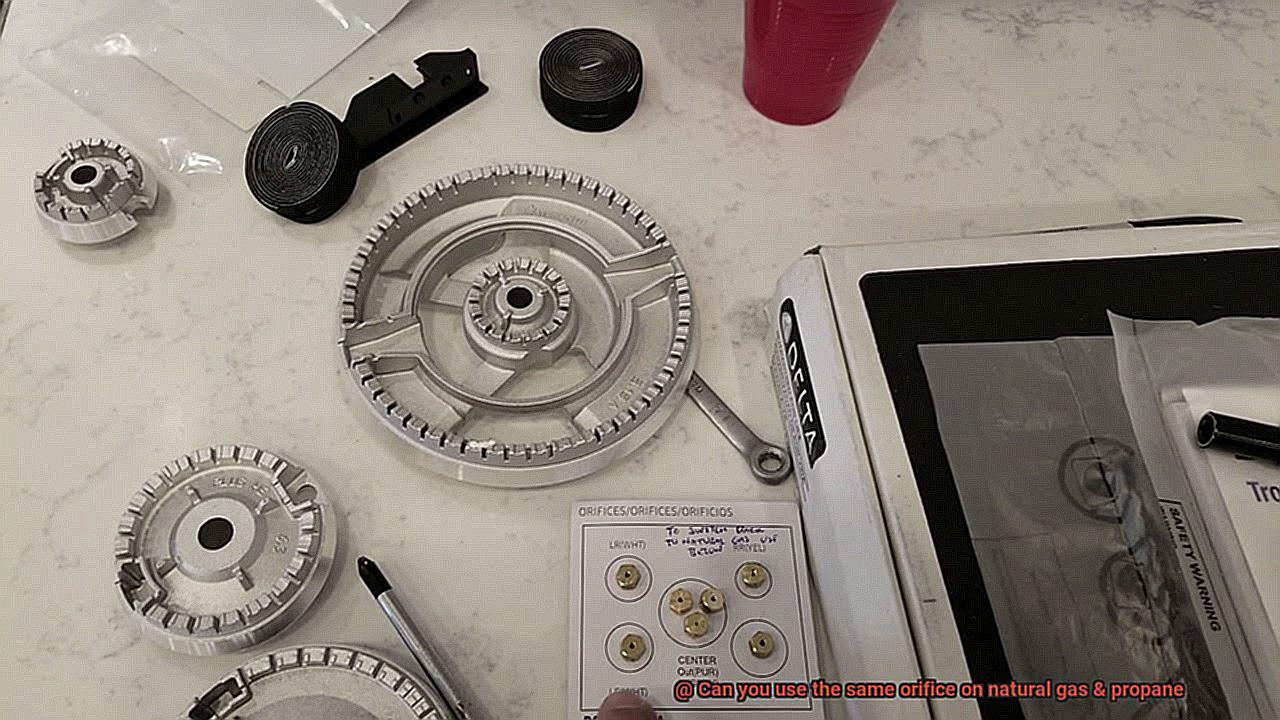
Natural gas and propane have distinct properties that affect their flow and pressure levels. Natural gas is a lighter gas with a lower pressure level, while propane is heavier and has a higher pressure level. The result is that natural gas requires a larger orifice to regulate its flow compared to propane.
Mixing up your orifices can lead to disastrous consequences. Using a propane orifice for natural gas will cause the flow rate to be too high, which can result in dangerous situations like explosions. Conversely, using a natural gas orifice for propane will result in inefficient heating due to the low flow rate.
So, what can you do to ensure safe and efficient grilling? It’s simple – use the appropriate orifice for your fuel type. While it may be tempting to use the same orifice for both fuels, this shortcut is not worth the risk of injury or poor performance.
To avoid any confusion, consult with a professional who can guide you on the best course of action. They’ll help you choose the right orifice for your grill, ensuring that your grilling experience is both enjoyable and safe.
Grills Designed to Run on Natural Gas
Then you might want to consider switching to a natural gas grill. However, before you make the switch, it’s crucial to understand why grills designed to run on natural gas require specific orifice sizes.
To begin with, an orifice is a small hole in the burner that regulates the flow of gas into the grill. The size of the orifice determines the amount of gas that is released into the burner and affects the heat output of the grill. Here’s where it gets interesting: natural gas and propane have different properties that require different orifice sizes.
Natural gas has a lower pressure than propane, which means that it needs a larger orifice size to achieve the same heat output. This is why grills designed to run on natural gas have larger orifices than those designed for propane. Using the same orifice for both types of gas can lead to insufficient heat output or even damage to the grill.
If you’re thinking about making the switch from propane to natural gas, it’s crucial to get a new grill with larger orifices designed specifically for natural gas. If you already have a propane grill and want to convert it to run on natural gas, you’ll need a conversion kit that includes a new regulator and hose that can handle the lower pressure of natural gas.
However, converting a propane grill to run on natural gas isn’t as simple as changing the orifice size. It requires professional assistance to ensure that safety and proper functioning are maintained. Attempting to do it yourself may result in damage or even danger.
In summary, here are some key takeaways:
Grills designed to run on natural gas require specific orifice sizes that are larger than those used for propane.
-Using the wrong orifice size for your type of fuel may lead to inadequate heat output or damage to the grill.
-If you’re considering switching to a natural gas grill, make sure you get one that’s designed specifically for natural gas.
-If you want to convert your propane grill, it’s vital to consult with a professional and purchase a conversion kit that includes all necessary components for safe and proper functioning.
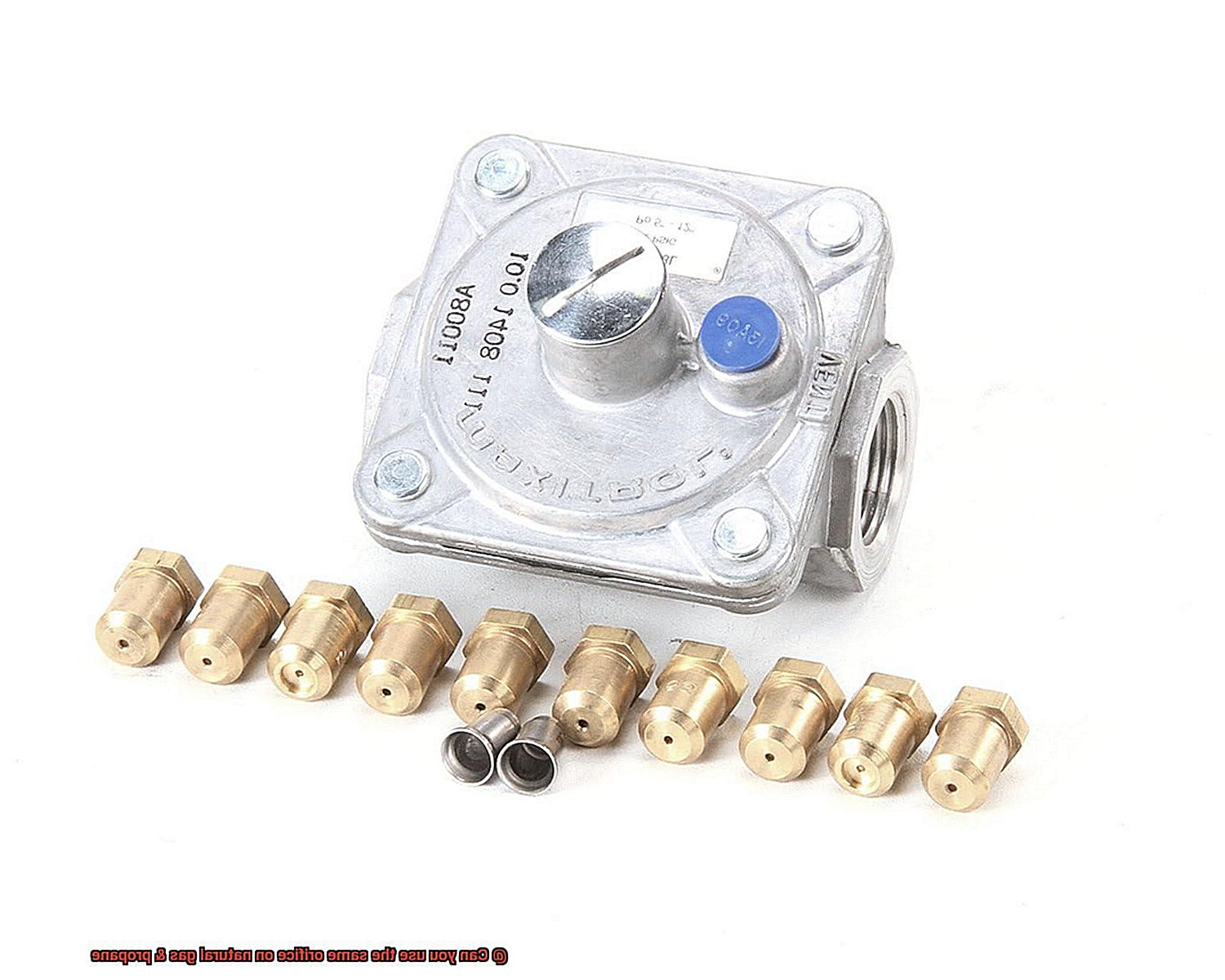
Grills Designed to Run on Propane
Before you do, it’s crucial to understand the differences in pressure and orifice size between the two gases. Incorrect use of orifices and regulators can lead to hazards and inefficiency, so let’s delve into why it’s essential to use the correct components when making the switch.
Propane grills are designed with orifices that match the gas’s specific diameter, making them suitable for regulating propane flow. Propane gas has a higher pressure than natural gas, meaning it requires a smaller orifice to control its flow. If you use a propane orifice on a natural gas grill, the flame will be weak, resulting in uneven cooking and longer cooking times.
That’s why it’s vital to use the proper orifices and regulators when converting your grill from propane to natural gas. Some grills can operate on both gases, but if yours cannot, don’t attempt the switch without the appropriate conversion kit. This kit includes different orifices and regulators designed for natural gas, ensuring safe and efficient operation.
It’s crucial to note that using incorrect components can lead to severe safety hazards such as fires, explosions, and carbon monoxide poisoning. Hence, make sure you follow the manufacturer’s instructions carefully when converting your grill. Though it may seem like a hassle, it is worth it for your safety and the quality of your grilled dishes.
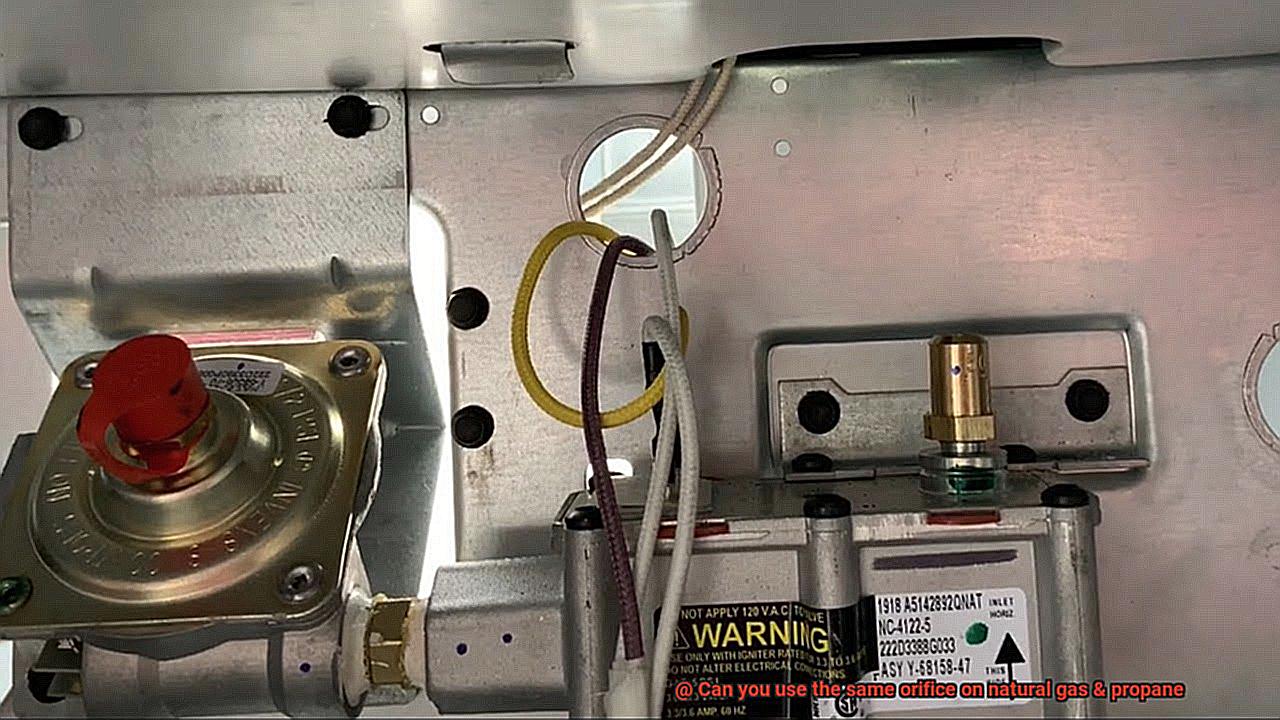
Convertible Grills Between Natural Gas and Propane
Convertible grills offer a solution to this problem, but the process of conversion can be confusing. As an expert in this field, I’m here to guide you through the process of converting your grill between natural gas and propane.
One of the most common questions that arise when it comes to convertible grills is whether the same orifice can be used for both natural gas and propane. Unfortunately, there is no straightforward answer. It depends on the type of grill you have and the conversion kit that came with it.
Luckily, modern convertible grills are designed to come with a conversion kit that includes different orifices for each fuel type. However, using the correct orifice for each fuel type is crucial to ensure proper performance, efficient fuel consumption, and safety compliance. Make sure to consult the manufacturer’s instructions for the correct orifice to use.
On the other hand, if you have an older grill that was not designed for conversion, it may not come with a conversion kit or compatible orifices. In this case, it is possible to retrofit the grill with a conversion kit, but it’s important to seek professional help. Improper installation can lead to safety hazards like fires and explosions.
In summary, if you have a convertible grill with a conversion kit, using the same orifice on natural gas and propane is possible as long as you use the correct one specified by the manufacturer. If you have an older grill without a conversion kit, it’s important to seek professional help before retrofitting it.
Replacing the Orifices for Different Fuels
Whether you’re a seasoned pit master or a beginner, converting your grill from propane to natural gas or vice versa can be a daunting task. But fear not – we’re here to help. As experts in grill conversion, we’re here to explain why replacing the orifices for different fuels is essential for your grill’s proper functioning and safety.
Firstly, let’s talk about what orifices are and why they matter. Orifices are small openings in the burner that regulate the flow of gas. The size of the orifice determines the amount of gas that flows through, which is critical for the proper functioning of your grill.
Propane and natural gas have different combustion properties, and therefore require different orifice sizes. Propane has a higher energy content than natural gas, which means it requires a smaller orifice to regulate the flow of gas properly.
Natural gas, on the other hand, has a lower energy content and requires a larger orifice to achieve the same heat output. Using incorrect orifices can lead to low flame output, which means your food won’t cook evenly or consistently.
Now, let’s dive into the sub-topics of why replacing the orifices is so crucial:
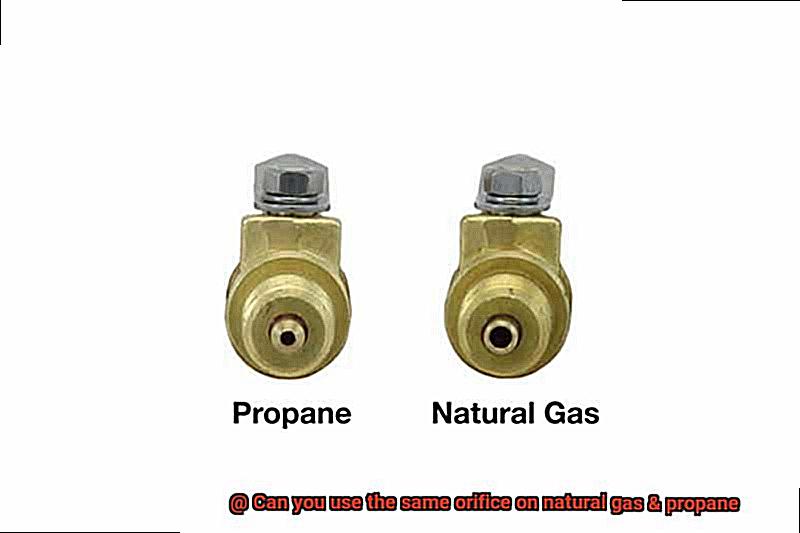
- Proper Functioning: Using incorrect orifices can result in poor heat distribution, uneven cooking, and even dangerous flames. You don’t want your burgers half-raw and half-burnt. Properly sized orifices will ensure that your grill functions as it should and that your food is cooked evenly and thoroughly.
- Safety Compliance: Safety should always be your top priority when working with gas grills. Using propane orifices with natural gas or vice versa can lead to dangerously high flames and even cause fires. Don’t take any chances with your safety and that of your loved ones.
- Easy Replacement Process: Replacing the orifices is a simple process that doesn’t require any special skills or tools. Most grills come with interchangeable orifices that you can swap out with a wrench or pliers. However, it’s crucial to ensure that you have the correct replacement orifices for your particular grill model and fuel type.
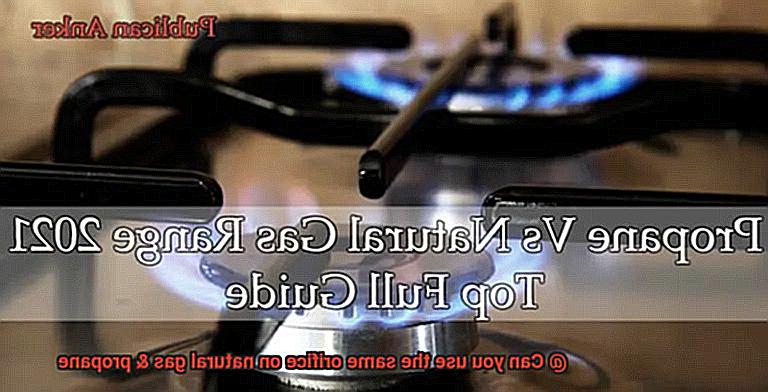
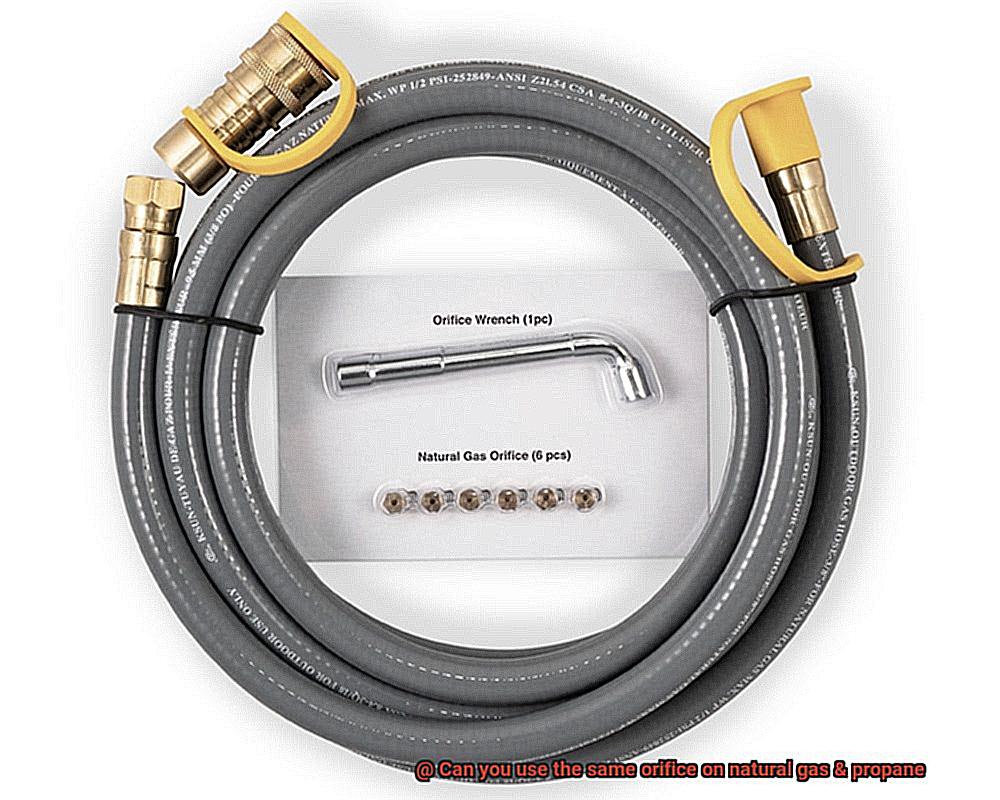
Dangers of Using the Wrong Size Orifice
This small hole, responsible for regulating the flow of gas in your grill or other appliance, may seem insignificant. However, if it’s not sized correctly, it can lead to serious consequences.
One of the most significant risks associated with using the wrong size orifice is an improper mixture of gas and air. This can create a potentially explosive situation that could harm you and those around you. Orifices are designed to regulate gas flow and are specifically sized for either natural gas or propane. Natural gas orifices have larger holes than propane orifices because natural gas is a lower pressure fuel. Using the wrong one can lead to incomplete combustion, which can result in carbon monoxide poisoning or even fire. This is no laughing matter.
But that’s not all – using the incorrect size orifice can also cause damage to your equipment. If you use a propane orifice with natural gas, it can cause damage to the burner and heat exchangers of your grill or other appliance. This damage can lead to a shortened lifespan of your equipment and potentially costly repairs.
To ensure safe and proper operation of your equipment, always use the correct orifice for the type of gas being used. When in doubt, consult with a professional or contact the manufacturer for guidance. It’s never worth risking your safety or others’ safety to save a few dollars on an orifice.
Tips for Switching Fuels in Your Grill
While it may seem like a daunting task, switching between propane and natural gas can be done safely and easily with the right tips and techniques. Here are five essential subtopics to consider before making the switch:
The Importance of Orifice Size
The orifice is a small but crucial component that regulates the flow of gas to the burner. It’s vital to use the correct orifice size for your specific fuel type. Propane requires a smaller orifice size than natural gas due to its higher pressure. Using the wrong orifice size can result in poor performance and safety hazards, so be sure to consult your owner’s manual or a professional technician before making any changes.
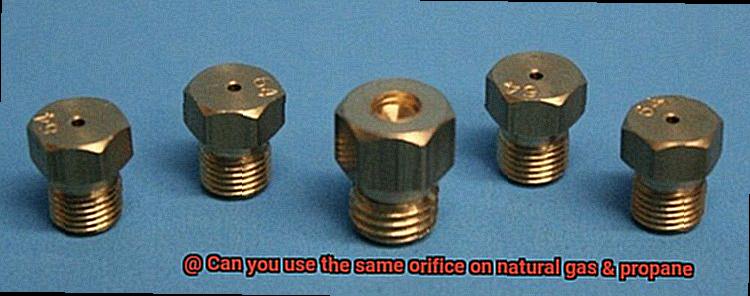
Consult Your Owner’s Manual or a Professional Technician
Before making any adjustments to your grill, it’s important to seek guidance from your owner’s manual or a professional technician. They can provide specific instructions tailored to your grill model and ensure that you have the correct orifice size for your chosen fuel type.
Adjusting the Air Shutter
The air shutter controls the ratio of fuel to air in the combustion process, and it needs to be adjusted when switching fuels. When switching from propane to natural gas, you’ll need to open the air shutter slightly to allow for proper combustion, while switching from natural gas to propane requires closing it slightly. This adjustment will help achieve optimal heat output and prevent flare-ups.
Adapting Your Grilling Technique
Switching fuels can impact your grilling technique and cooking times, as natural gas burns at a lower temperature than propane. This means you may need to adjust your cooking times accordingly. With practice, you’ll be able to achieve great-tasting food regardless of the fuel type by experimenting with different grilling techniques.
Flavor Differences
Propane burns hotter than natural gas, resulting in a different taste and texture. Some grillers prefer one fuel type over the other for this reason. However, by adjusting your technique and experimenting with flavors, you can still achieve delicious grilled food regardless of the fuel type.
Et4rBQovAHY” >
Conclusion
In conclusion, it’s important to remember that propane and natural gas are not interchangeable fuels. Each has its unique properties that affect the performance of your appliances, which means using the same orifice on both is not recommended.
Mixing up your orifices can lead to inefficient burning and dangerous situations like explosions. To avoid these risks, always use the correct orifice for the type of gas being used. It’s crucial to consult professionals before attempting any conversions to ensure everything is done safely and efficiently.
If you’re thinking about switching between propane and natural gas, whether it’s for environmental reasons or because you’re moving into a new home, understanding your appliance’s unique gas needs is essential. Grills designed to run on natural gas require specific orifice sizes that are larger than those used for propane. Propane grills, on the other hand, are designed with orifices that match the gas’s specific diameter, making them suitable for regulating propane flow.
Convertible grills offer a solution to this problem, but the process of conversion can be confusing. To ensure safe and proper operation of your equipment, always follow manufacturer guidelines and consult with a professional if necessary.
By using the correct orifice size for your fuel type, you can achieve optimal performance from your appliances while ensuring safety in their operation.

